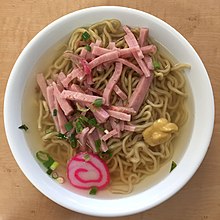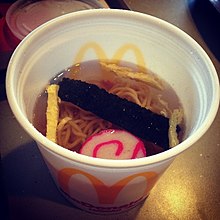
Japanese cuisine encompasses the regional and traditional foods of Japan, which have developed through centuries of political, economic, and social changes. The traditional cuisine of Japan is based on rice with miso soup and other dishes; there is an emphasis on seasonal ingredients. Side dishes often consist of fish, pickled vegetables, and vegetables cooked in broth. Seafood is common, often grilled, but also served raw as sashimi or in sushi. Seafood and vegetables are also deep-fried in a light batter, as tempura. Apart from rice, a staple includes noodles, such as soba and udon. Japan also has many simmered dishes, such as fish products in broth called oden, or beef in sukiyaki and nikujaga.
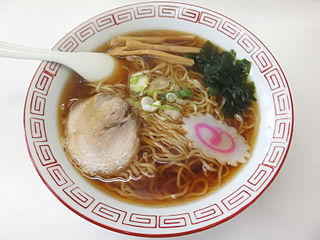
Ramen is a Japanese noodle dish. It consists of Chinese-style wheat noodles served in a broth; common flavors are soy sauce and miso, with typical toppings including sliced pork, nori, menma, and scallions. Ramen has its roots in Chinese noodle dishes. Nearly every region in Japan has its own variation of ramen, such as the tonkotsu ramen of Kyushu and the miso ramen of Hokkaido.

Soba is a thin Japanese noodle made from buckwheat. The noodles are served either chilled with a dipping sauce, or hot in a noodle soup. The variety Nagano soba includes wheat flour.

Champon, also known as Chanpon, is a noodle dish that is a regional cuisine of Nagasaki, Japan. There are different versions in Japan, Korea and China. The dish was inspired by Chinese cuisine.
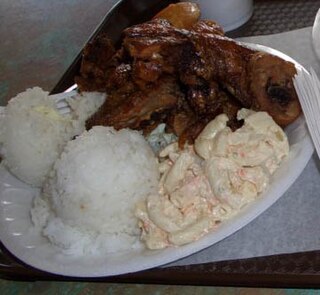
The plate lunch is a quintessentially Hawaiian meal, roughly analogous to Southern U.S. meat-and-threes. However, the combination of American and pan-Asian influence makes the plate lunch unique to Hawaii.
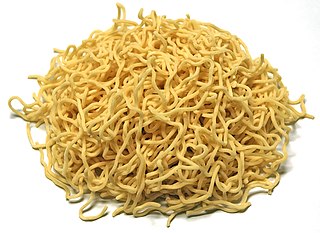
Noodles are a staple of Japanese cuisine. They are often served chilled with dipping sauces, or in soups or hot dishes. Noodles were introduced to Japan from China during the Song Dynasty between the Heian until the early Kamakura period.

The cuisine of Hawaii incorporates five distinct styles of food, reflecting the diverse food history of settlement and immigration in the Hawaiian Islands.

Japanese Chinese cuisine, also known as Chūka, represents a unique fusion of Japanese and Chinese culinary traditions that have evolved over the late 19th century and more recent times. This style, served predominantly by Chinese restaurants in Japan, stands distinct from the "authentic Chinese food" found in areas such as Yokohama Chinatown. Despite this difference, the cuisine retains strong influences from various Chinese culinary styles, as seen in the Shippoku cooking style.
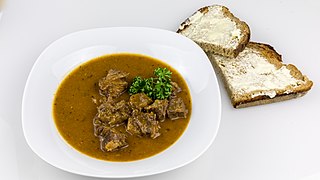
Oxtail soup is a soup made with beef tails. The use of the word "ox" in this context is a legacy of nomenclature; no specialized stock of beef animals are used and tails may come from bovines other than oxen. It is believed by some that oxtail soup was invented in Spitalfields in London in the seventeenth century by French Huguenot and Flemish immigrants, from the tails of animals. Different versions of oxtail soup exist: Korean; Chinese; a fried/barbecued oxtail combined with soup variation which is a popular dish in Indonesia where it is called as sop buntut; an ethnic dish of the American South which traces its lineage back to the pre-revolutionary war era; and a thick, rich, gravy-like soup popular in the United Kingdom since the 18th century. Creole oxtail soup is made from a tomato base with oxtails, potatoes, green beans, corn, mirepoix, garlic, and herbs and spices.
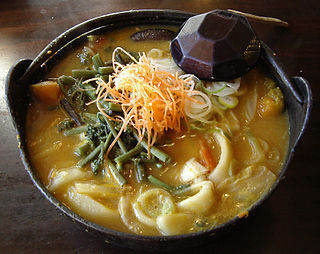
Hōtō (ほうとう) is a noodle soup and popular regional dish originating from Yamanashi, Japan made by stewing flat udon noodles and vegetables in miso soup. Though hōtō is commonly recognized as a variant of udon, locals do not consider it to be an udon dish because the dough is prepared in the style of dumplings rather than noodles.

White cut chicken or white sliced chicken is a type of siu mei. Unlike most other meats in the siu mei category, this particular dish is not roasted, but steamed. The dish is common to the cultures of Southern China, including Guangdong, Fujian and Hong Kong. In Hawaii, this popular dish is known as cold ginger chicken.
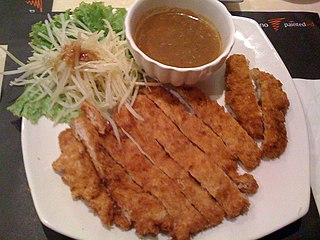
Chicken katsu, also known as panko chicken, or tori katsu is a Japanese dish of fried chicken made with panko bread crumbs. It is related to tonkatsu, fried pork cutlets. The dish has spread internationally and has become a common dish served at Japanese and East Asian restaurants worldwide.

Yaka mein is a type of beef noodle soup found in many Creole restaurants in New Orleans. It is also a type of Chinese wheat noodle.
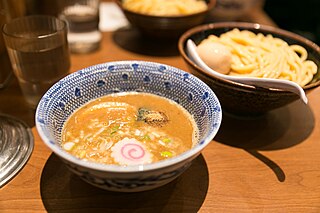
Tsukemen is a ramen dish in Japanese cuisine consisting of noodles that are eaten after being dipped in a separate bowl of soup or broth. The dish was invented in 1961 by Kazuo Yamagishi, a restaurateur in Tokyo, Japan. Since then, the dish has become popular throughout Japan, as well as overseas in the United States.

A ramen shop is a restaurant that specializes in ramen dishes, the wheat-flour Japanese noodles in broth. In Japan, ramen shops are very common and popular, and are sometimes referred to as ramen-ya(ラーメン屋) or ramen-ten(ラーメン店). Some ramen shops operate in short order style, while others provide patrons with sit-down service. Over 10,000 ramen shops exist in Japan. In recent times, ramen shops have burgeoned in some cities in the United States, such as Chicago, Los Angeles, and New York City.

Hapa PDX is a restaurant in Portland, Oregon.

Okazuya or okazu-ya are a Japanese-style delicatessen common in Hawaii. Unlike western delicatessens found in North America or Europe, an okazuya is an establishment that sells readymade Japanese-styled food. "Okazu" refers to a side dish to accompany rice, while "ya" refers to a retail establishment.
